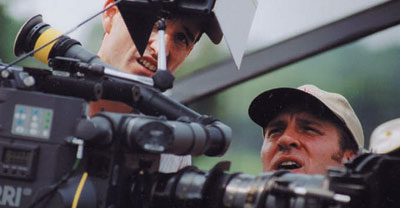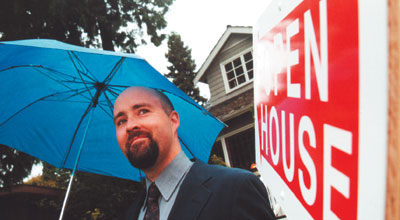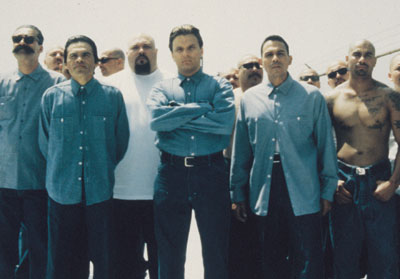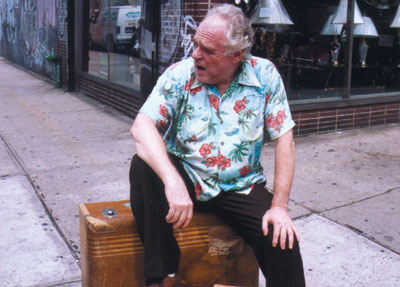IN FOCUS
Mary Glucksman profiles six new feature films in production.
BRINGING RAIN
Noah Buschel, 22, was signed by the Gersh Agency last year after a scout attended a Fifth Night reading of his Neal Cassady screenplay. Buschel had a Marvin Gaye screenplay making the rounds as well, but rather than choose one of those biopics for his directorial debut, he hooked up with Belladonna Productions and independent producer and founder of Noah Shanachie Management, Dan O’Meara, to make the ensemble drama Bringing Rain. The boarding school–set tragedy is about a senior class coming to terms with a drunk-driving accident the previous year in which the school’s star swimmer lost a leg when her boyfriend, played by Adrian Grenier, crashed his jeep after a class party. The teens all share a sense of guilt, and none have been able to move on with their lives.
“Like Catcher in the Rye or A Separate Peace, we’re using the accident as a metaphor for adolescence,” says Buschel. “[Adrian’s character] is now a creepy specter,” adds O’Meara. “He’s on campus, but he doesn’t go to class and he spends a lot of time in his jeep smoking joints. Everyone tiptoes around him because he’s such a reminder of what happened.”
Belladonna principal Linda Moran says she warmed to Rain as the company’s first film since the release of L.I.E. because of its tone. “It’s told very poetically, with lots of fantasy elements, and it’s more carefully drawn than anything I’ve seen from a first-time director.”
Rain’s three-week August shoot on a New Jersey prep school campus, financed in the six-figure range with private equity, was one of the first features to employ the Ikegami camera. “[Director] Bob Gosse tested it for us, and we blew the footage up at DuArt — it’s about the closest thing to 24P you can get shooting on DV,” says O’Meara, who is currently prepping stage-to-screen feature Jailbait with Gosse.
Also in Rain are Noah Fleiss (Joe the King), Merritt Wever (Series 7), Ray Santiago (Girlfight), Nathalie Paulding (Bully), Paz De La Huerta (Chelsea Walls), and newcomers Niesha Butler (a Georgia Tech basketball star), Alexis Dziena and Rodrigo Lopresti.
Contact:Linda Moran at moranlr@aol.com.
CORN
 |
| D.p. H. Michael Otano and director Dave Silver on the set of Corn. PHOTO: ERIC ANDERSON. |
Dave Silver’s Gasline won the Jury Prize in Short Filmmaking at this year’s Sundance Film Festival, but the chance encounter that lead to the financing of his first feature occurred at the Newport Film Festival six months earlier. Silver showed Gasline there too and was carpooling home from a party when he found himself in a van with director and fest board member Michael Corrente (Outside Providence). “He asked me to read his script and produce it,” says Corrente. “This business is all about relationships, and you never know where they are going to start.”
What Silver didn’t know then was that Corrente was just a month away from announcing Revere Pictures, a new partnership with high-tech billionaire Roger Marino (co-founder of EMC Corporation) bankrolled to produce five films a year at budgets up to $20 million. Silver’s feature, Corn, is the first greenlight from Revere, and its budget is rather lower (“Around a million,” according to Corrente).
In the vein of Silkwood or Rosemary’s Baby, Corn is about a young woman (Jena Malone) who seeks refuge on her father’s sheep ranch after an affair with the politician she works for leaves her pregnant. When the sheep turn preternaturally aggressive after munching weeds produced by a neighbor’s biogenetically altered corn crop, she embarks on an investigation that also exposes uncomfortable truths in her own family.
“It’s a dark, gothic kind of story that crosses a lot of territory,” says Silver. “I wanted to meditate on biology and our ability to control it in the context of an experiment that goes badly wrong. It’s in a storytelling tradition that goes back to Edgar Allan Poe and Mary Shelley.”
A Columbia MFA film student when he made Gasline, Silver abandoned an illustrious career as creative director for ad agency Ogilvy & Mather to enter the program in 1998. The 35mm Corn was shot in New Jersey, Yonkers, downtown Manhattan and at Columbia University over 25 days this July and August.
Contact: Michael Corrente at michael@reverepictures.com.
MAX AND GRACE
Michael Parness was on his fourth career when he stepped behind the camera to direct the comedy Max and Grace in New York this August. Originally the proprietor of a thriving sports memorabilia business that supported his efforts as a playwright, theater director and screenwriter, he lost most of his savings in the October '98 stock market crash. Down to $33,000, he opened an online brokerage account and in 15 months turned it into $7 million; Parness launched financial guru site trendfund.com along the way and recounts his experiences in the 2002 bestseller, Rule the Freakin' Markets. All that made him famous in financial circles and a regular in their media. Dustin Hoffman's Punch Productions even optioned his life story. But he still wanted to make a movie.
"It's what I've wanted to do my whole life," says Parness. "Film allows you to take to the next level what you can do on the stage, like showing a character's inner thoughts or using special effects to highlight emotion."
Grace stars David Krumholtz and Natasha Lyonne as suicidal lovers who get married in a hospital ward and escape for a honeymoon that teaches them that there's more to marriage than wishing you were dead. The film was produced with private equity by FilmNext's Gene Miller, who previously produced and directed Parness's play Lactose Intolerance and Other Urban Afflictions. "We met Off-Broadway at The Trilogy Theater - one of my plays opened the day after his closed," says Miller.
Grace will be the first feature to test out new facilities at Staten Island's Stapleton Studios, a ten-stage complex being built out of the carcass of a defunct Navy shipyard and adjoining production plant that will eventually house the largest soundstage in the U.S.
Contact: Gene Miller (producer) at gmiller@filmnext.corp.
OPEN HOUSE
 |
| Jeffrey Hogan in the short film version of Open House. PHOTO: DAN MIRVISH. |
Dan Mirvish was fine-tuning the script for his first feature since Omaha (The Movie) when he was invited to participate in the Seattle Film Festival’s Fly Filmmaker Series. Fly’s concept is simple: Bring three established directors to Seattle to shoot five-minute DV shorts that screen before the event wraps. Mirvish shot an excerpt from his script Open House, and it turned out to be both a crowd pleaser and a tool in igniting feature financing.
The feature version of House is a musical comedy about a jewel thief who operates by slipping in among touring home buyers. “The whole concept of open houses is really strange,” says Mirvish. “You open your door and let strangers walk in. When my wife and I were shopping for a house, she’d be checking out room size while I went through people’s stuff. You learn a lot about people from the way they live.”
Mirvish wrote House with film editor Larry Maddox (Star Maps) and brought in composer Joe Kraemer (The Way of the Gun) to help with songs.
House shoots in L.A. in October with d.p. Alex Vendler (Kurt and Courtney) using 24P, 16mm or 35mm, depending on whether Mirvish hits a $20,000, $50,000 or $200,000 budget bump. He’s currently talking to a group of realtors whose financing will determine the size of his budget. If that sounds like a pie-in-the-sky way to proceed into production, consider the wizard behind the curtain. When Sundance ’95 rejected Omaha, Mirvish created the renegade Slamdance Film Festival, spawning the whole alterna-fest movement in Park City; he used a 32-festival run with tons of press to fuel a 35-city theatrical self-release in mainstream theaters, and sold Omaha to the Sundance Channel. A deal with Pioneer to insert Omaha DVDs in every player shipped in North America put 350,000 units in circulation.
“The trick is to not take no for an answer,” says Mirvish.
Contact: Dan Mirvish at dmirvish@slamdance.com.
EL PADRINO
 |
| Damian Chapa (center) and gang members in El Padrino. PHOTO: MARTIN MUNTENBRUCH. |
El Padrino is Spanish for “The Godfather” and that’s just the kind of morally complex tale Damian Chapa’s three-generation Mexican-American drug-gang drama aspires to be. The main character, played by Chapa as an adult, is a five-year-old Mexican American living an ordinary life with his Anglo mom when his extravagant drug-dealer dad takes him away for six months. Starting as a teenage drug runner, he builds an empire with ties to Jamaican mobsters, the Crips and the Bloods in an ascent that continues even through a prison stint. Then hard drugs reach his own son’s grade school.
“It’s an epic tragedy,” says Chapa. “The son becomes everything his father wanted to be only to find out too late he made the wrong choice.”
Originally a theater actor who broke into film as star of Taylor Hackford’s ’93 Blood In, Blood Out, Chapa, now 39, developed his talent as director with a pair of shorts and a genre pic, The Calling. Before that he took a year off from acting to immerse himself in cinema history and fell in love with the work of Fellini and Hungarian director András Jeles’s The Annunciation, a history of mankind cast entirely with children. “I learned about imagery from them,” he says. “You have to have the confidence to convey to the d.p. what you feel in your heart. If you don’t, your dailies will be just as dead and insecure as you are.”
The 35mm El Padrino was shot in East L.A. and Malibu beginning July 5 under the SAG Modified Low-Budget Agreement. The film was financed by rap producer Troy Barker and the cast includes Jennifer Tilly, Faye Dunaway, Robert Wagner, Stacy Keach, Joanna Pacula, Brad Dourif and Gary Busey.
How did Chapa land seasoned actors like that for a less-than-$1-million indie? Dunaway and Wagner were friends from past collaborations, and the rest followed, he says. “We had no money and had to rely solely on on-site creativity, but that gives you a kind of adrenaline you can't get from all the money and equipment in the world."
Contact: Damian Chapa at damian_chapa@yahoo.com
THE SIGHTSEER
 |
| Joel Rooks in The Sightseer. PHOTO: MICHEL NEGROPONTE. |
Michel Negroponte first experimented with evolving straightforward doc into fiction with W.I.S.O.R., in which a robot built to repair steam pipes under city streets learns to speak. With his new film, The Sightseer, he takes the hybrid form much further. "It's a history of a marriage superimposed on a history of New York - a dramatic feature that uses a lot of documentary elements," he says. "After 40 years of marriage, Leo's wife wants him out. The day he finally leaves, the planes go into the World Trade Center. It's a really sad story."
Leo, Sightseer's philosopher and history teacher protagonist, is stuck in the past; he projects his memories onto the city as he meanders past spots like Times Square and Fifth Avenue during the St. Patrick's Day parade. Archival footage functions as an allegory for iconic chapters in his life, such as his father's role in building the Empire State Building. Negroponte was already planning to incorporate Universal Newsreel footage of a B-25 bomber crashing into the Empire State in the 1940s when 9/11 happened - now one event is a foreshadowing of the other.
Negroponte started work on Sightseer a year and a half ago. "It's one of those projects that starts in one place and ends in another," he says. "I was testing my new PD-150 [camera]. I got some of the best material I'd ever filmed so I thought I should do a kind of fictionalized diary." He recruited City College philosophy professor Nick Pappas (also a writer) as a partner on the script, co-photographed the film with Neil Leventhal, and edited it himself. Joel Rooks (On the Run) and Lynn Cohen (The Jimmy Show) star as Leo and his wife; at press time Negroponte was locking down a 75-minute rough cut.
Contact: Michel Negroponte at michelneg@aol.com.
VOD CALENDAR


 See the VOD Calendar →
See the VOD Calendar →


